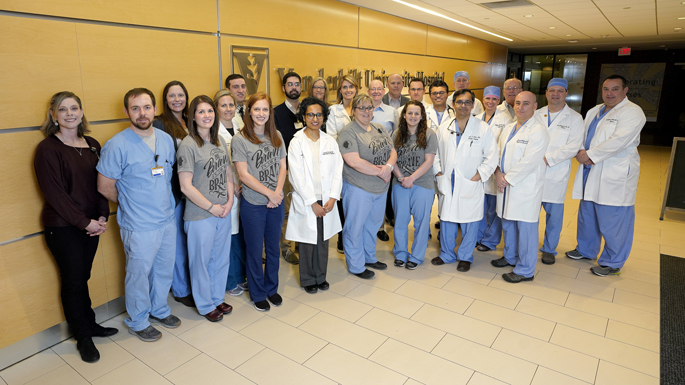
Steven Chastain was driving home from work when his heart went dangerously out of rhythm and he lost consciousness.
“I woke up in a guard rail,” said Chastain, 29, who lives near Knoxville, Tennessee.
In November 2018, Chastain received a ventricular assist device (VAD) at Vanderbilt Heart and Vascular Institute (VHVI) to keep his heart in rhythm, a temporary solution while he waits for a permanent one — a heart transplant. The VAD is an implantable, mechanical support system that pumps blood through his body when his heart is too sick to do it.
VHVI’s cardiac surgery and heart failure teams recently celebrated a milestone — implanting the 500th adult patient with a VAD. The first LVAS (left ventricular assist system) at Vanderbilt University Medical Center was implanted in 1986, according Vanderbilt archives.
“Each one of the 500 patients and families is part of a greater journey in advanced heart disease,” said Ashish Shah, MD, professor and chair of Cardiac Surgery. “The highs have been high, and lows have been low. However, our devotion as a team to these vulnerable patients grows with each case. These devices continue to evolve and provide hope. Importantly, Vanderbilt will continue to be a leader toward a better future for patients with advanced heart disease.”
Vanderbilt Heart’s life-saving VAD program offers a spectrum of devices to serve two populations of end-stage heart failure patients whose medical management is failing. Some patients use it as a bridge to stay alive until a heart transplant. For others, it’s a destination therapy to serve them for the rest of their lives.
“We are at the forefront of this field,” said Sandip Zalawadiya, MBBS, medical director of the Ventricular Assist Device program at VUMC. “We are one of the highest-implanting VAD centers in the United States, with an average of 50 implants per year over the past three years. We offer our patients access to cutting-edge devices,” including the Abbott HeartMate 3 and Medtronic HeartWare in addition to the Syncardia Total Artificial Heart (TAH).
VUMC was the first hospital in Tennessee to implant a total artificial heart in 2018.
Chastain said his VAD has enabled him to lead a relatively normal life while he waits for a heart transplant. He’s not working until he gets his new heart, but he said he feels good. He and his wife, Christian, are expecting their second child in June — a boy to join their 6-year-old daughter, Maleia.
“I’m grateful for it,” he said of his VAD. “Very grateful… It does make your life better.”
Chastain has had a long road to this point. He was born with a healthy heart, but at age 17 his aorta was punctured in an accident with fireworks. His doctors in Ohio initially thought he needed a transplant, but he recovered enough to live a normal life with his injured heart. That continued for the next 10 years, as he worked for a railroad and then for a hospice.
Kelly Schlendorf, MD, medical director of Vanderbilt’s adult heart transplant program, recalls first meeting Chastain when he was referred to VHVI for heart failure management.
“Despite having a sick and very enlarged heart, Steven fared well on medical therapies for many years before he started to decline,” Schlendorf said. “When he did, given his blood type and his tall height, we anticipated that he would wait a long time for a new heart — hence the decision to proceed with the VAD. For Steven and so many other waitlisted patients like him, the VAD has provided a bridge that allows patients who might otherwise die on the waitlist to survive until transplant.”
By the time he received his VAD, his heart had developed scar tissue and had accumulated calcium in a way that made the implant procedure difficult.
In addition, one of his key heart valves (aortic valve) was also leaking significantly. Complexity and complications from the procedure meant he had to stay in the intensive care unit for two weeks, and in Nashville for a total of 71 days. But he recovered and is now doing well.
“I really feel like if I didn’t get the VAD … I wouldn’t have made it,” Chastain said.
“I distinctly remember how stressed Mr. Chastain and his young family were when he was first admitted to our Intensive Care Unit,” Zalawadiya said.
“He was sick and had a complicated medical and surgical history, all of which meant that we needed to act fast, be efficient and have an intricate coordination of multidisciplinary care. Through the exemplary care he received, he went home with his LVAD and is now looking forward to his life. I am very happy for him and congratulate his family in welcoming a wonderful new addition.”
Steve Janson, VAD program manager, said Chastain’s situation was unusual. “On average, a person who receives a VAD will spend just under three weeks in the hospital as they learn the equipment and work on getting stronger,” he said. “If they live farther than one hour, they will have to stay locally for four to six weeks as we see them very often and have them get labs drawn frequently.”
Chastain’s care team remarked about the resilience of their patients.
“Our patients are often some of the toughest people we know, with their own stories and life events and challenges,” said Cayce Ake, RN, one of the five VAD coordinators along with Jessica Hassler, RN; Kerry Rechel, RN; Amy Whitley, RN and Madeline Fowler, RN. “And yet they always find a way to fight and overcome the obstacles that they face.”
“The VAD is just another one of those obstacles, a stepping stone to transplant or to a longer, more fulfilling life for many,” said Casey West, CRNP, VAD nurse practitioner.
Chastain credited his Vanderbilt team.
“I’ve really not found anything wrong with any of them” on the care team, he said. “Their bedside manners are amazing. They’re very sympathetic.”












